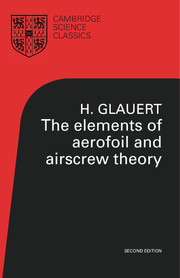Book contents
- Frontmatter
- PREFACE
- PREFACE TO SECOND EDITION
- Contents
- REFERENCES
- Chap. I Introduction
- Chap. II Bernoulli's Equation
- Chap. III The Stream Function
- Chap. IV Circulation and Vorticity
- Chap. V The Velocity Potential and the Potential Function
- Chap. VI The Transformation of a Circle into an Aerofoil
- Chap. VII The Aerofoil in Two Dimensions
- Chap. VIII Viscosity and Drag
- Chap. IX The Basis of Aerofoil Theory
- Chap. X The Aerofoil in Three Dimensions
- Chap. XI The Monoplane Aerofoil
- Chap. XII The Flow round an Aerofoil
- Chap. XIII Biplane Aerofoils
- Chap. XIV Wind Tunnel Interference on Aerofoils
- Chap. XV The Airscrew: Momentum Theory
- Chap. XVI The Airscrew: Blade Element Theory
- Chap. XVII The Airscrew: Wind Tunnel Interference
- Appendix
- Bibliography
- Index
Chap. VIII - Viscosity and Drag
Published online by Cambridge University Press: 01 June 2011
- Frontmatter
- PREFACE
- PREFACE TO SECOND EDITION
- Contents
- REFERENCES
- Chap. I Introduction
- Chap. II Bernoulli's Equation
- Chap. III The Stream Function
- Chap. IV Circulation and Vorticity
- Chap. V The Velocity Potential and the Potential Function
- Chap. VI The Transformation of a Circle into an Aerofoil
- Chap. VII The Aerofoil in Two Dimensions
- Chap. VIII Viscosity and Drag
- Chap. IX The Basis of Aerofoil Theory
- Chap. X The Aerofoil in Three Dimensions
- Chap. XI The Monoplane Aerofoil
- Chap. XII The Flow round an Aerofoil
- Chap. XIII Biplane Aerofoils
- Chap. XIV Wind Tunnel Interference on Aerofoils
- Chap. XV The Airscrew: Momentum Theory
- Chap. XVI The Airscrew: Blade Element Theory
- Chap. XVII The Airscrew: Wind Tunnel Interference
- Appendix
- Bibliography
- Index
Summary
The drag of a bluff body.
The theory of the two-dimensional motion of a perfect fluid has led to the determination of the lift of an aerofoil by means of the assumption of a circulation of the flow, but the solution is incomplete in several respects. The conditions which cause the circulation to develop at the commencement of the motion have not been investigated and the magnitude of the circulation is indeterminate except in the case of an aerofoil with a sharp trailing edge. Joukowski's hypothesis that the circulation must be such that the flow leaves the trailing edge smoothly also requires critical examination. Finally, the theory has not indicated the existence of any drag force on the aerofoil.
To examine these problems fully it is necessary to depart from the simple assumption of a perfect fluid and to determine the effects of the viscosity or internal friction, but some insight into the drag of a body can be obtained without introducing this complication. In developing the theory of the lift force it was convenient to consider the class of bodies which give a large lift force associated with a relatively small drag force, so that the latter might be neglected without modifying the essential conditions of the problem. Similarly in examining the drag force it is convenient to consider in the first place bodies of bluff form, symmetrical about the direction of motion, so that the lift force is zero and the drag force is large.
- Type
- Chapter
- Information
- The Elements of Aerofoil and Airscrew Theory , pp. 94 - 116Publisher: Cambridge University PressPrint publication year: 1983



